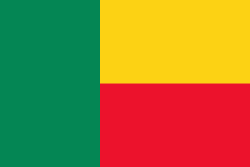Littoral Department (Littoral)
Littoral is one of the twelve departments of Benin. At 79 km2, Littoral is the smallest department in the country. Its capital is Cotonou, Benin's largest city. The department was created in 1999 with the splitting up of territories of Atlantique Department.
As per 2013 census, the total population of the department was 679,012 with 325,872 males and 353,140 females. The entire population was urban while the total labour force in the department numbered 253,892. The proportion of households with no level of attained formal education was 21.1%, by far the lowest of any department in the country.
Littoral Department borders Ouémé Department and Atlantique Department and is situated in a coastal area that has interconnected lakes and lagoons and elongated coastlines with wide marshes. Freshwater and seawater fishing is the major profession in the region. Petroleum was discovered in the 1960s in offshore areas, while titanium, low-quality iron ore, ilmenite and chromite are the major minerals. The southern regions of Benin receive two spells from March to July and September to November while the northern regions of the country receive one season of rainfall from May to September. The country receives an average annual rainfall of around 1200 mm, but Littoral Department receives less rainfall. The department's region has mostly low-lying sandy coastal plains towards the Atlantic Ocean, marshes, lagoons and lakes. The highest elevation in the department around the coastal plains is 20 m compared to the average 200 m above average mean sea level of the country.
As per 2013 census, the total population of the department was 679,012 with 325,872 males and 353,140 females. The entire population was urban while the total labour force in the department numbered 253,892. The proportion of households with no level of attained formal education was 21.1%, by far the lowest of any department in the country.
Littoral Department borders Ouémé Department and Atlantique Department and is situated in a coastal area that has interconnected lakes and lagoons and elongated coastlines with wide marshes. Freshwater and seawater fishing is the major profession in the region. Petroleum was discovered in the 1960s in offshore areas, while titanium, low-quality iron ore, ilmenite and chromite are the major minerals. The southern regions of Benin receive two spells from March to July and September to November while the northern regions of the country receive one season of rainfall from May to September. The country receives an average annual rainfall of around 1200 mm, but Littoral Department receives less rainfall. The department's region has mostly low-lying sandy coastal plains towards the Atlantic Ocean, marshes, lagoons and lakes. The highest elevation in the department around the coastal plains is 20 m compared to the average 200 m above average mean sea level of the country.
Map - Littoral Department (Littoral)
Map
Country - Benin
 |
 |
| Flag of Benin | |
From the 17th to the 19th century, political entities in the area included the Kingdom of Dahomey, the city-state of Porto-Novo, and other states to the north. This region was referred to as the Slave Coast from the early 17th century due to the high number of people who were sold and trafficked during the Atlantic slave trade to the New World. France took over the territory in 1894, incorporating it into French West Africa as French Dahomey. In 1960, Dahomey gained full independence from France. As a sovereign state, Benin has had democratic governments, military coups, and military governments. A self-described Marxist–Leninist state called the People's Republic of Benin existed between 1975 and 1990. In 1991, it was replaced by the multi-party Republic of Benin.
Currency / Language
| ISO | Currency | Symbol | Significant figures |
|---|---|---|---|
| XOF | West African CFA franc | Fr | 0 |
| ISO | Language |
|---|---|
| FR | French language |















